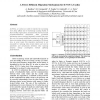Free Online Productivity Tools
i2Speak
i2Symbol
i2OCR
iTex2Img
iWeb2Print
iWeb2Shot
i2Type
iPdf2Split
iPdf2Merge
i2Bopomofo
i2Arabic
i2Style
i2Image
i2PDF
iLatex2Rtf
Sci2ools
DATE
2009
IEEE
2009
IEEE
A power-efficient migration mechanism for D-NUCA caches
D-NUCA L2 caches are able to tolerate the increasing wire delay effects due to technology scaling thanks to their banked organization, broadcast line search and data promotion/demotion mechanism. Data promotion mechanism aims at moving frequently accessed data near the core, but causes additional accesses on cache banks, hence increasing dynamic energy consumption. We shown how, in some cases, this migration mechanism is not successful in reducing data access latency and can be selectively and dynamically inhibited, thus reducing dynamic energy consumption without affecting performances.
Data Promotion Mechanism | Data Promotion/demotion Mechanism | DATE 2009 | Dynamic Energy Consumption | Hardware |
| Added | 20 May 2010 |
| Updated | 20 May 2010 |
| Type | Conference |
| Year | 2009 |
| Where | DATE |
| Authors | Alessandro Bardine, Manuel Comparetti, Pierfrancesco Foglia, Giacomo Gabrielli, Cosimo Antonio Prete |
Comments (0)

